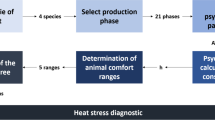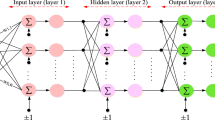Abstract
There is an increasing use of robust analytical algorithms in the prediction of heat stress. The present investigation therefore, was carried out to forecast heat stress index (HSI) in Sasso laying hens. One hundred and sixty seven records on the thermo-physiological parameters of the birds were utilized. They were reared on deep litter and battery cage systems. Data were collected when the birds were 42- and 52-week of age. The independent variables fitted were housing system, age of birds, rectal temperature (RT), pulse rate (PR), and respiratory rate (RR). The response variable was HSI. Data were analyzed using automatic linear modeling (ALM) and artificial neural network (ANN) procedures. The ALM model building method involved Forward Stepwise using the F Statistic criterion. As regards ANN, multilayer perceptron (MLP) with back-propagation network was used. The ANN network was trained with 90% of the data set while 10% were dedicated to testing for model validation. RR and PR were the two parameters of utmost importance in the prediction of HSI. However, the fractional importance of RR was higher than that of PR in both ALM (0.947 versus 0.053) and ANN (0.677 versus 0.274) models. The two models also predicted HSI effectively with high degree of accuracy [r = 0.980, R2 = 0.961, adjusted R2 = 0.961, and RMSE = 0.05168 (ALM); r = 0.983, R2 = 0.966; adjusted R2 = 0.966, and RMSE = 0.04806 (ANN)]. The present information may be exploited in the development of a heat stress chart based largely on RR. This may aid detection of thermal discomfort in a poultry house under tropical and subtropical conditions.





Similar content being viewed by others
References
Abdul Niyas PA, Chaidanya K, Shaji S, Sejian V, Bhatta R, Bagath M, Rao GSLHVP, Kurien EK, Girish V (2015) Adaptation of livestock to environmental challenges. J Vet Sci Med Diagn 4:3 https://doi.org/10.4172/2325-9590.1000162
Adedeji TA, Amao SR, Ogundairo OM, Fasoyin OA (2015) Heat tolerance attributes of Nigerian locally adapted chickens as affected by strain and some qualitative traits. J Biol Agric Healthcare 5:50–55
Aggarwal Y, Karan BM, Das BN, Sinha RK (2008) An unsupervised neural network to predict the level of heat stress. J Clin Monitor Comp 22:425–430
Akbarian A, Michiels J, Degroote J, Majdeddin M, Golian A, De Smet S (2016) Association between heat stress and oxidative stress in poultry; mitochondrial dysfunction and dietary interventions with phytochemicals. J Anim Sci Biotech 7(37):37. https://doi.org/10.1186/s40104-016-0097-5
Hornik K, Stinchcombe M, White H (1989) Multilayer feedforward networks are universal approximators. Elsevier Sci 2(5):359–366
Hurvich CM, Tsai CL (1989) Regression and time series model selection in small samples. Biometrika 76:297–307
Ilori BM, Peters SO, Yakubu A, Imumorin IG, Adeleke MA, Ozoje MO, Ikeobi CON, Adebambo OA (2011) Physiological adaptation of local, exotic and crossbred turkeys to the hot and humid tropical environment of Nigeria. Acta Agric Scand A- Anim Sci 61:204–209
Krüger E, Rossi F, Drach P (2017) Calibration of the physiological equivalent temperature index for three different climatic regions. Int J Biometeorol 61:1323–1336
Kumari KNR, Nath DN (2017) Ameliorative measures to counter heat stress in poultry. World’s Poult Sci J (in press) 74:117–130. https://doi.org/10.1017/S0043933917001003
Laaboudi A, Mouhouche B, Draou B (2012) Neural network approach to reference evapotranspiration modeling from limited climatic data in arid regions. Int J Biometeorol 56:831–841
LaFaro RJ, Pothula S, Kubal KP, Inchiosa ME, Pothula VM, Yuan SC, Maerz DAML, Oleszkiewicz SM, Yusupov A, Perline R, Inchiosa MA Jr (2015) Neural network prediction of ICU length of stay following cardiac surgery based on pre-incision variables. PLoS One 10(12):e0145395. https://doi.org/10.1371/journal.pone.0145395
Lemerle C, Goddard ME (1986) Assessment of heat stress in dairy cattle in Papua New Guinea. Trop Anim Health Prod 18:232–242
Lopes AZ, Yanagi T Jr, Lacerda WS, Rabelo G (2014) Predicting rectal temperature of broiler chickens with artificial neural network. Int J Eng Tech 14(5):29–34
Mignon-Grasteau S, Moreri U, Narcy A, Rousseau X, Rodenburg TB, Tixier-Boichard M, Zerjal T (2015) Robustness to chronic heat stress in laying hens: a meta-analysis. Poult Sci 94:586–600
Mishra N, Soni HK, Sharma S, Upadhyay AK (2018) Development and analysis of artificial neural network models for rainfall prediction by using time-series data. Int J Intel Syst Appl (1):16–23
Nazareno AC, Da Silva IJO, Fernandes DPB (2016) Prediction of mean surface temperature of broiler chicks and load microclimate during transport. Eng Agríc 36:593–603
Nidamanuri AL, Murugesan S, Mahapatra RK (2017) Effect of heat stress on physiological parameters of layers-a review. Int J Livest Res 7:1–17
Osakwe I, Igwe R (2015) Physiological responses of laying birds fed honey and vitamin C in drinking water. Tropentag: Conference on international research on food security, natural resource management and rural development organised by the Humboldt-Universität zu Berlin and the Leibniz Centre for Agricultural Landscape Research (ZALF). September 16–18, 2015, Berlin, Germany
Osti R, Bhattarai D, Zhou D (2017) Climatic variation: effects on stress levels, feed intake, and bodyweight of broilers. Braz J Poult Sci 19:489–496
Rojas-Downing MM, Nejadhashemi AP, Harrigan T, Woznicki SA (2017) Climate change and livestock: impacts, adaptation, and mitigation. Clim Risk Management 16:145–163
Roush W, Cravener TL, Kirby YK, Wideman RF Jr (1997) Probabilistic neural network prediction of ascites in broilers based on minimally invasive physiological factors. Poult Sci 76(11):1513–1516
Ryder AA, Feddes JJR, Zuidhof MJ (2004) Field study to relate heat stress index to broiler performance. J Appl Poult Res 13:493–499
Sassi NB, Averós X, Estevez I (2016) Technology and poultry welfare. Animals 6. https://doi.org/10.3390/ani6100062
Sinkalu VO, Ayo JO (2018) Combined effects of retinol, ascorbic acid and α-tocopherol on diurnal variations in rectal temperature of Black Harco pullets subjected to heat stress. Int J Biometeorol 62:9–15
Sirajuddin SN, Lestari VS, Saleh IM, Sara U, Kasim J (2017) Effect of climate change on laying hen farms. Int J Sci Basic Appl Res 32:206–214
Šleger V, Neuberger P (2006) Using meteorological data to determine the risk of heat stress. Res Adr Eng 52:39–47
SPSS (2015) Statistical Package for Social Sciences Version 23. SPSS Inc., 444 Michigan Avenue, Chicago, IL60611, 2015
Tseliou A, Tsiros IX, Nikolopoulou M (2017) Seasonal differences in thermal sensation in the outdoor urban environment of Mediterranean climates—the example of Athens, Greece. Int J Biometeorol 61:1191–1208
Xie J, Tang L, Lu L, Zhang L, Xi L, Liu H-C, Odle J, Luo X (2014) Differential expression of heat shock transcription factors and heat shock proteins after acute and chronic heat stress in laying chickens (Gallus gallus). PLoS One 9(7):e102204. https://doi.org/10.1371/journal.pone.0102204
Yang H (2013) The case for being automatic: introducing the automatic LINEAR modeling (LINEAR) procedure in SPSS statistics. Multiple linear regression. Viewpoints 39(2):27–37
Zahoor I, de Koning D-J, Hocking PM (2017) Transcriptional profile of breast muscle in heat stressed layers is similar to that of broiler chickens at control temperature. Genet Sel Evol 49:69. https://doi.org/10.1186/s12711-017-0346-x
Acknowledgements
The Senate research grant of Nasarawa State University, Keffi to carry out this research is gratefully acknowledged. African Chicken Genetic Gains-Nigeria (ACGG-Ng) project donated the Sasso birds. Many thanks to the ACGG-Nigeria Principal Investigator (PI), Prof. E.B. Sonaiya, the Co-PI, Prof. Mrs. O.A. Adebambo, and the National Project Coordinator, Dr. Oladeji Bamidele.
Author information
Authors and Affiliations
Corresponding author
Ethics declarations
Competing interests
The authors declare that they have no competing interests.
Electronic supplementary material
ESM 1
(XLS 30.5 kb)
Rights and permissions
About this article
Cite this article
Yakubu, A., Oluremi, O. & Ekpo, E. Predicting heat stress index in Sasso hens using automatic linear modeling and artificial neural network. Int J Biometeorol 62, 1181–1186 (2018). https://doi.org/10.1007/s00484-018-1521-7
Received:
Revised:
Accepted:
Published:
Issue Date:
DOI: https://doi.org/10.1007/s00484-018-1521-7




